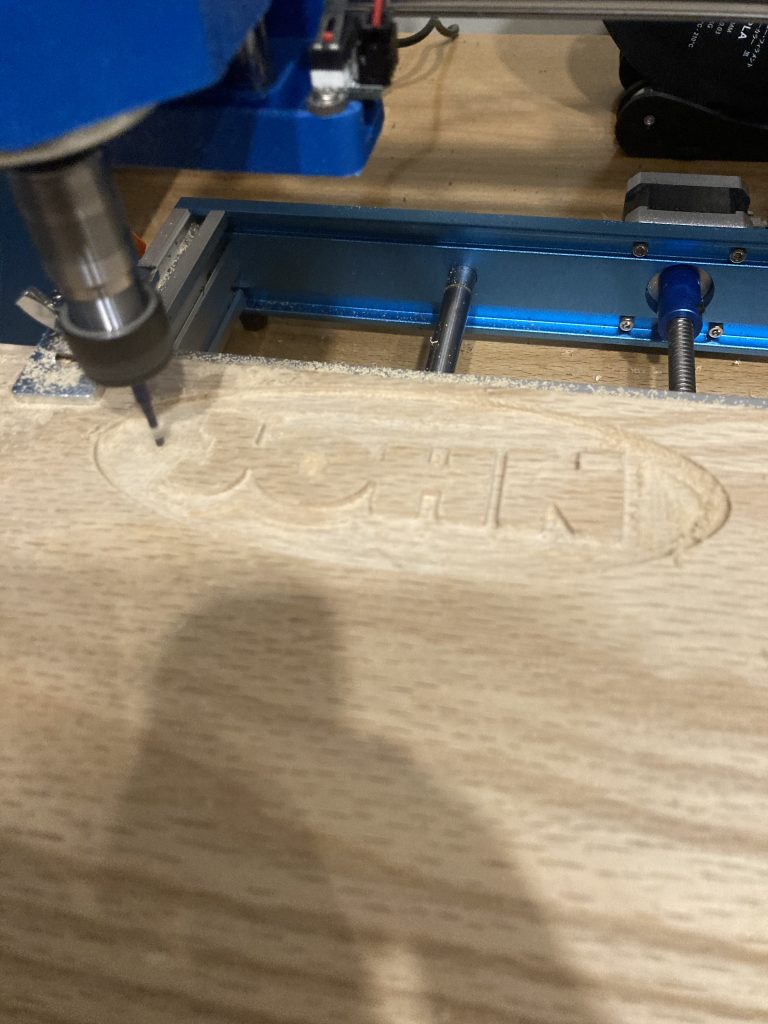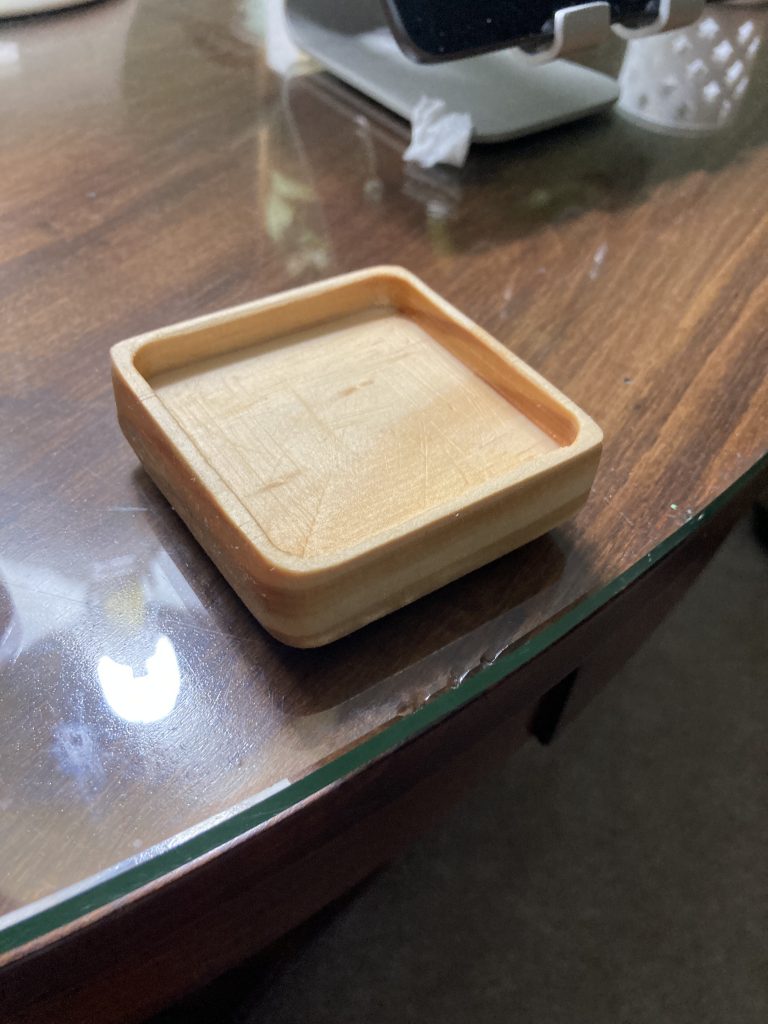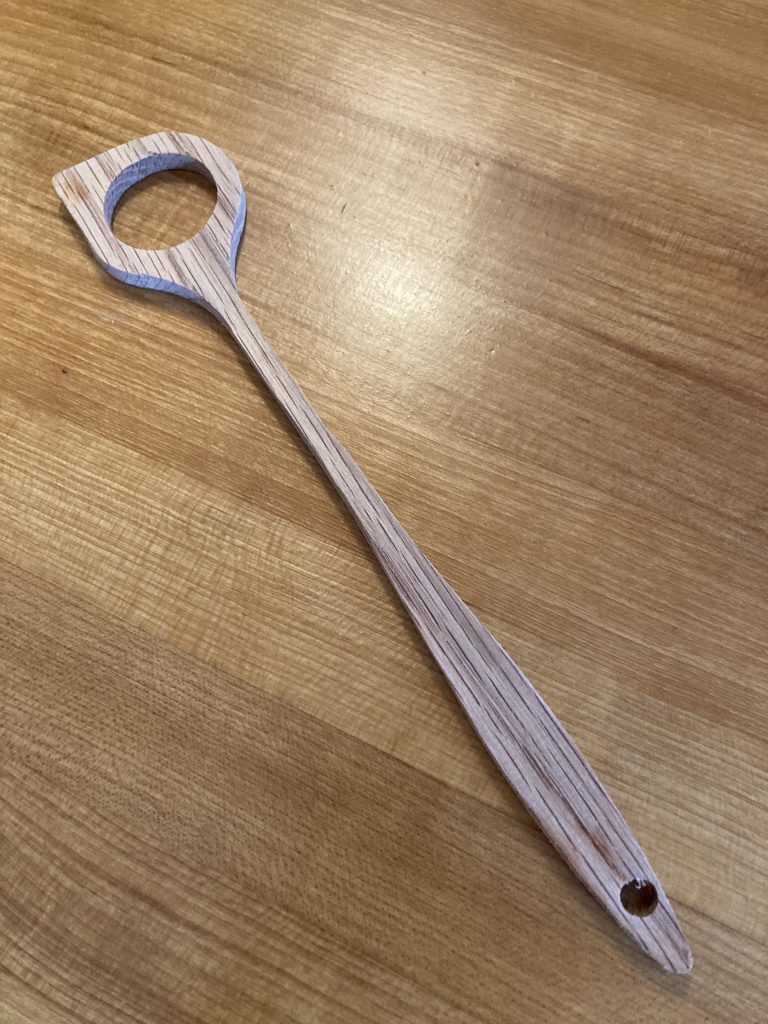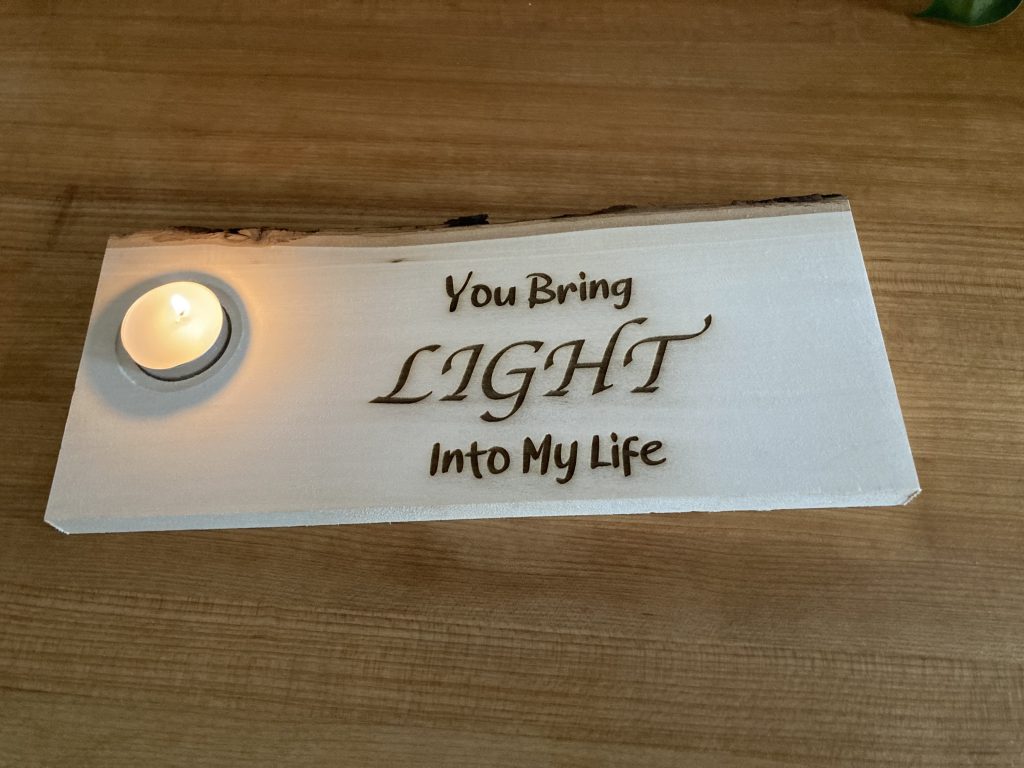Like the title says……..these are just my first observations.
I have been cutting vinyl signs for 15 or more years, 3D printing for 7 or so years, and using lasers for a couple of years, so I have some experience with computerized things moving along 2 or 3 axises.
CNC stands for Computer Numerical Control which just means a machine is automated by a computer. I started this because I was making cool stuff in my laser but was limited by my woodworking skills. I was given a real life wood router which really picked my game up and keeps me from spending extra money on pre-routed wood blanks at the hobby stores. Anyway, I caught the woodworking bug and invested in an entry level CNC machine.
Enter the Sainsmart 3018 Prover. I must have caught it just right on a Black Friday Sale or something because I paid around $250 and the price immediately went up about $50 – $100 depending on where you buy it from. Before I talk about the machine I’ll throw down some general impressions of CNC.
Here are a few notes I jotted down after my first session or two with the machine.
- For a first time user it is preferable to set the machine up via a computer and with Windows OS. This kinda stinks because I truly hate Windows. It is possible to set up and use the machine offline or to use it with Mac or Linux, but I stand by my statement that it is EASIER FOR A FIRST TIMER doing it from Windows.
- My machine DID NOT WORK right out of the box. After hooking it up, carefully and correctly, and getting drivers installed on the computer………IT DID NOT WORK. No axis moved however it was trying to move and the status light on the main board was lighting up with commands and the machine seemed to be TRYING to move, but it didn’t move. I decided to re-flash the main board with its firmware which surprisingly brought it back to life. My machine came with CORRUPT FIRMWARE. I’ve been playing with Arduino and GRBL for years and this wasn’t too horrific, however if you don’t know how to do such things it could be a major PITA. Sainsmart support was poised to send me a replacement board. They were quick in responding so that should alleviate some fears to the non-techie inclined.
- Once I got it going I was able to calibrate the Z axis with the included probe and then every time I tried to cut I would get a spindle alarm. It took me a while to figure this out but my bit was installed way up in the holder and the material I was testing a cut on was only 5mm thick. As the machine lowered to cut, it kept hitting the limit switch which of course shut down the operation. Once I pulled the bit out a little and raised the piece I was working on a little bit the machine immediately began doing what it was supposed to do.
- When you work on a laser or a CNC you generally put down a sacrificial work surface called a spoil board. That is so when you foul up it damages the cheap spoil board and not your table or nice work surface. The machine I bought does not come with a spoil board which kind of stinks, however it isn’t a dealbreaker.
- Software choices are staggering. There is no shortage of software out there and not great freeware offerings. When you are a new dude the free stuff is okay but you’ll quickly grow out of it.
- Depending on your software choice(s) you may need 2 or even 3 hunks of software to complete your workflow. If you can design stuff in CAD software all you need to do is convert it to G-Code which another program can send to the CNC.
- Software that does it all is EXPENSIVE and once again I have to say that Windows software kind of rules the roost in CNC. Yes, there are ways to effectively use Mac and Linux but the spit and polish programs either have monthly or annual subscription plans or cost a lot right out of the chute.
- If you are JUST GOING TO BE A HOBBYIST you are best suited to learning the freeware methods and keeping your designs and projects simplistic in nature. If you want to make a few bucks selling your wares you probably should invest in some specialized software.
- Before you get a machine, join The Sainsmart Facebook User Group. Read all you can and ask your newbie questions before you get the machine. I have found the group to be super useful and I get solid answers to my newbie questions quickly.
As you can see, some of my initial observations were about software. The Windows software that comes with the machine is called Candle. It comes with version 1.17 but there seems to be a beta 1.2b version. Not sure why they don’t use it and I haven’t tried to use it yet. Basically you need G-Code and Candle sends it to the machine. If you haven’t designed anything and converted it to G-Code, then Candle won’t take you very far.
Inventables has free web-based software called Easel which Sainsmart recommends for users with newer Mac OS’s. I have just started dabbling with it and it is pretty intuitive however I hate web-based stuff. No internet connection, no Easel. If one day Inventables goes “POOF”, no more Easel. Or maybe one day you log in and THEY WANT MONEY. Maybe I’m old school but just give me the darn software please. Easel initially gives you “Pro” which drops the pro features after 30 days. While I kind of recommend using it for the first timer, I can’t recommend spending $120 a year to keep a couple of feature. A 3 year subscription is almost $450. If you are going to spend that kind of money you might as well get some more advanced software.
EASEL ISSUE: This probably won’t be an issue for most but I run a local DNS server on my firewall appliance. All of my computers inside the house have the DNS settings pointed to that server for a variety of security reasons. The Easel driver WILL NOT connect unless I use an outside DNS (i.e. 1.1.1.1, 8.8.8.8, 8.8.4.4, etc.). This does not make me very happy and makes me want to use the offline controller supplied with the machine more and more.
For now I’ll be using Easel but a company called Vectric has some software offerings that not only are awesome but they have excellent training videos as well. Their software offerings range from pretty affordable to really expensive. Aspire is about $2000. I won’t be using Aspire but if I were going to open a store front and sell my awesome creations you can bet I’d invest in it. It’s probably best in class however best in class is always whatever works best for you. If you want to carve your wife’s name on a cutting board……….you don’t need $2000 worth of software.
Carbide Create is another popular one and it is downloadable software AND it runs on a Mac. And of course it is pretty basic and its big brother Carbide Create Pro costs $120 annually or you can buy it forever for $360 but can only update it for a year. While I don’t like that business model I have to admit the premier laser software Lightburn, does about the same thing. Carbide Create Pro looks pretty compelling.
But once again……..if you can carve your wife’s initials on a bread board or keychain with the free stuff, and that’s all you ever do………..there’s no need to spend ANY money. My recommendation is to use free software UNTIL YOU GROW OUT OF IT.

Action Photo!
So, now let’s talk about the machine. I called it “entry level” earlier but I think that really extends to cost. You can hand a guy the most expensive paint brush and canvas but if you can’t paint it doesn’t matter how good the paint brush is.
I’ve witnessed some of the projects made by users of this CNC and all I can say is the machine is as capable as the operator. You can make some excellent creations provided your designs are artistic and eye appealing.
Maybe the weak point on the machine (strictly, in my opinion) is the 775 motor that drives the bit. Having said that……..The motors can be had for just a few dollars. Order a couple of spares.
One thing I like is that the frame is nice and solid and construction to get up and running is fairly simply. Lead screws instead of round stock and bearings and belts is a definite plus in a machine like this.
Despite having minimal experience, and after playing with test cuts, I managed to pull off my first couple of serious cutting attempts. Check them out.
3018 Prover – First Cuts (click pics to enlarge)
If I had any complaints……..and I really don’t, I guess it would be “I already want bigger and faster”. This machine is kind of slow but I would be willing to bet I could adjust things and speed things up. Faster is not always better anyway. A bigger workspace for sure would be beneficial.
Having said that……….They sell a kit that doubles the length of the Y axis for $59.99. Join their newsletter and they’ll give you $10 off the kit. Sadly this puts you under their free shipping limit of $50 and shipping is, you guessed it, $10. Order yourself some bits or something. Heck you’re going to order different kinds of bits anyway so just do it now. That’s what I did.
AFTER A FEW MORE DAYS WITH THIS MACHINE…………….SOME MORE OBSERVATIONS.
- The clamping system is awful. Yeah, the clamps are fine and strong and hold stuff but the working area to install them is awful. If you clamp down a singular thin piece of wood, it is great. If you put a piece of 3/4″ thick wood that doesn’t quite fit perfectly in the T grooves…….well…….prepare to say some bad words. No room for hands.
- It gets worse if you want TO CUT THROUGH thick wood, which means it needs to have a waste board or scrap under it………unless you want to grind on the nice aluminum bed. Clamping is EVEN HARDER then. I recommend some 3mm plywood to use as a waste board and to clamp it down. Then use the “blue painters tape with super glue” method to secure your piece to the waste board. Forget clamping your work piece. You’ll be amazed how strong it is gluing blue tape to blue tape.
- Along the same lines……….without the online controller hooked up you need to jog the machine to get it out of your way while you do that stuff. My machine is hooked to a Mac. You really need Candle on Windows to easily jog.
- YOU NEED MORE STUFF. The included engraving bits are cool but if you want to make a bowl or tray or cut through material you NEED MORE BITS. I did the stuff in the pics below with different bits.
- You need to buy a 1/4″ collet. And I did buy one. Then I bought a router bit kit at Harbor Freight AND THEY DON’T FIT. 1/4″ = 6.35mm and the Chinese Harbor Freight bit shafts mic out a tiny bit thicker than that. I bought a set of bits from Sainsmart and they fit like a champ. Beware the bits that you buy.
- Along those same lines…….YOU NEED A SET OF DIAL CALIPERS. I know we live in the US of A with our Imperial measurement system but I greatly prefer mm. Get one that will do both. I bought these Neiko several years ago and swear by them.
- When you put a bit in you need to TIGHTEN THAT MOTHER DOWN. I’ve had two bits drop out during cutting on me. I did an hour cut the other day and the bit fell out with 8 minutes left. Ruined. Piece of oak too.
- Along those lines……..you may think it crazy to do things twice but if it is IMPORTANT to you……run the job on MDF or scrap before running it on expensive hardwood. Yeah, it doubles your time but I bet you’ll thank me for that tip.
More advanced stuff (click pics to enlarge)
I think my master plan is to exploit this machine, make a couple bucks, and get a more industrial type machine. In the interim this is $250 well spent. A bigger machine probably means some of that fancy software I talked about earlier and that is a more significant investment. I think I’d need a real reason to upgrade besides “I want one.”
I’ve changed my mind about the statement in the paragraph above. After getting the machine, some bits, some collets, a Y extension kit, and some other things I’m probably forgetting I’m already lusting after a Shapeoko 4. I probably should have just bought one from the get go.
I still don’t regret this purchase because I didn’t think I could use a CNC successfully. I figured it would be a waste of money because of my horrific, non-existent, wood working skills. Turns out I have skills. Spending over $2500 on a big boy pants machine and accessories and software is not the right path to figuring out if you can do something or not. Start small and cheap.
IF WHAT I SAID JUST DESCRIBES YOU………….BUY THE SAINSMART 3018 PROVER AND DON’T LOOK BACK. YOU CAN SELL IT, GIVE IT TO YOUR KID, TEACH A BEGINNERS CLASS WITH IT, OR USE IT FOR A BACKUP OR TO CRANK OUT SMALL WIDGETS.
Again I think it does thin material engraving BEAUTIFULLY and clamping isn’t too horrific. You just have to exploit the things the machine does efficiently and well.
While I may have said a thing or two that seemed like something for the Minus Column, rest assured that I find no fault with this machine and in fact LOVE IT. CNC’s are not toys. And they require some technical know how even though product maturation has made things more intuitive these days. You are not going to get a CNC, a laser, or a 3D printer and not hit a speed bump or two in the learning process. You just aren’t.
Someone I once knew used to say……..”If you crowd the plate, expect the bean ball.” Computerized machines throw the occasional bean ball. And then you learn from it.








Good blog John. You’re off & runningz learn new techniques every day, absorb knowledge of others & enjoy the hell out of it
Thanks John……you’ve been a big help to me.